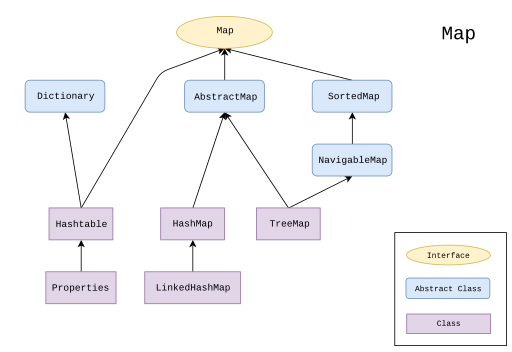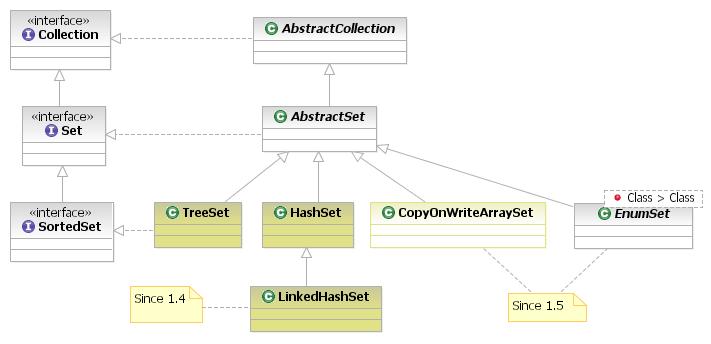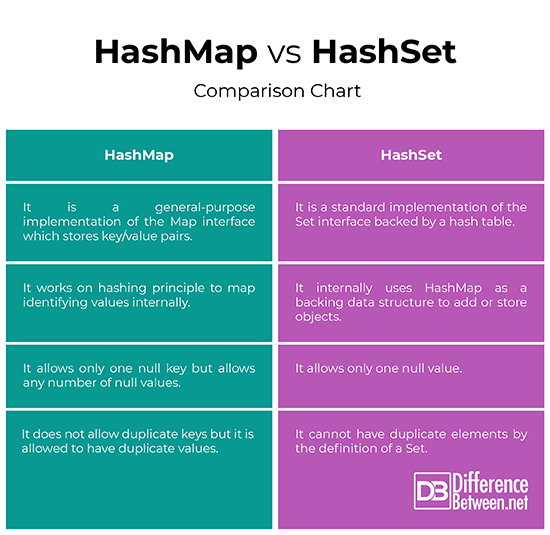Difference Between HashMap and HashSet
When you learn a new computer language, one of the first things you tend to ask is how to work with large groups of data. This topic is often covered under the topic “Data Structures”. If you dig deeper, you must come around topics such as linked lists, queues, stacks, and binary trees among many other data structures. In Java, these structures are part of the Java Collections Framework. A collection is nothing but a type of data structure which refers to a grouping of multiple data elements and the Java Collections Framework standardizes the way in which these groups of objects are handled. In fact, the collections framework was designed to meet several goals.
The entire collections framework is designed around a set of standard interfaces. Several standard implementations such as LinkedList, HashSet, and TreeSet are provides by these interfaces that you may as-is. In addition, you can also implement your own collection if you choose. However, in addition to collections, the framework defines several map interfaces and classes. Java contains three general-purpose map implementations – HashMap, TreeMap and LinkedHashMap – which store key/value pairs. Although maps are not technically collections, they are fully integrated with collections. In fact, maps focus on groups of association between objects. This article summarizes the key differences between HashMap and HashSet.

What is a HashMap?
HashMap is the most commonly used implementation of the Map interface which provides a basic key/value map where the elements are unordered. It uses a special value called a hash code, instead of a slow search of the key. The hash code is a way to take information in the object in question and turn it into a “relatively unique” int for that object. It simply works on hashing principle which means it uses a hash function to map identifying values. Just like Vector and Stack have their replacements in ArrayList and LinkedList, Hashtable has a replacement in HashMap. It extends AbstractMap to implement the Map interface using an internal Hashtable representation. And similar to other general-purpose implementations, HashMap supports the optional methods of Map, allows null values, and is not synchronized.
What is a HashSet?
HashSet is one of the members of the Java Collections Framework which implements the Set interface, backed by a hash table which is in fact a HashMap instance. As the name implies, it is implemented by a hash table, an array in which elements are stored at a position derived from their contents. Unlike a Map, Set is exactly a Collection with exactly the same interface, so there isn’t any extra functionality like there is with two different Lists. HashSet uses a hashing function which is designed specifically for rapid lookups. It is an unordered collection of unique objects which cannot store duplicate values. HashSet extends AbstractSet class which implements Set interface. However, HashSet doesn’t define any additional methods other than those provided by its superclasses and interfaces.

Difference Between HashMap and HashSet
-
Basic
HashMap is the most commonly used implementation of the Map interface which provides a basic key/value map where the elements are unordered. It simply works on hashing principle which means it uses a hash function to map identifying values. HashSet, on the other hand, is one of the members of the Java Collections Framework which implements the Set interface, backed by a hash table which is in fact a HashMap instance. Simply speaking, HashMap implements the Map interface, whereas HashSet implements the Set interface.
-
Functionality
HashSet creates a collection that uses a hash table for storage. Hash table stores information using a method called hashing. HashSet uses a hashing function, which is specifically designed for rapid lookups, to store elements or values. Most of the HashSet functionality is provides through the AbstractCollection and AbstractSet superclass, which HashSet shares with TreeSet. HashMap extends AbstractMap to implement the Map interface using an internal Hashtable representation. Both the classes are not synchronized meaning they are not suitable for thread-safe operations.
-
Duplicate Values
Because Map does not support duplicate keys, HashMap does not allow duplicate keys but it is allowed to have duplicate values. This means duplicate values can exist in HashMap but you can use collection as value against some key. Each key must be unique in a HashMap and a single key cannot be allowed to have more than 1 value. HashSet, on the other hand, cannot have duplicate elements by the mere definition of a Set, which means you cannot store duplicate values in HashSet. HashMap allows only one null key but allows any number of null values, whereas HashSet allows only one null value.
-
Storing Mechanism
HashMap works on hashing principle which means it uses a hash function to map identifying values internally using the hashing algorithm to enable easy retrieval. A true hashing mechanism always returns the same hashCode( ) when applied to the same object. HashSet, on the other hand, internally uses HashMap as a backing data structure to add or store objects. This means when an object of HashSet is created, it will create an object of HashMap.
HashMap vs. HashSet: Comparison Chart

Summary of HashMap Vs. HashSet
Although both HashMap and HashSet are not synchronized meaning they are not suitable for thread-safe operations and they are entirely different constructs, they provide constant time performance for basic operations such as adding, removing element etc. While HashMap is a general-purpose implementation of the Map interface which stores key/value pairs, HashSet is an implementation of the Set interface. A HashSet does use a HashMap to back its implementation. A HashMap, however, uses hashing principle and use it to quickly hunt for the key.
- Difference Between Serif and Sans Serif - April 22, 2024
- Difference Between HTML and Text - April 19, 2024
- Difference Between FTP and SFTP - April 16, 2024
Search DifferenceBetween.net :
 Email This Post
: If you like this article or our site. Please spread the word. Share it with your friends/family.
Email This Post
: If you like this article or our site. Please spread the word. Share it with your friends/family.
1 Comment
Leave a Response
References :
[0]Zukowski, John. Java Collections. New York City: Apress, 2008. Print
[1]Eckel, Bruce. Thinking in Java. New Jersey: Prentice Hall, 2003. Print
[2]Naftalin, Maurice and Philip Wadler. Java Generics and Collections. Sebastopol, California: O'Reilly Media, 2006. Print
[3]Image credit: https://upload.wikimedia.org/wikipedia/commons/3/3b/Java_collection_set_implementations.jpg
[4]Image credit: https://en.wikipedia.org/wiki/Java_collections_framework#/media/File:Java.util.Map_hierarchy.svg


HashSet exhibits constant-time performance for the basic operations (add, remove, contains and size).HashSet does not guarantee that the order of elements will remain constant over time.
TreeSet guarantees log(n) time cost for the basic operations (add, remove and contains). TreeSets guarantee that elements of the set will be sorted in ascending, natural, or the one specified by you via its constructor. (by implementing Comparable interface).
Overall great Blog on this Java topic.